<iframe style="width:120px;height:240px;" marginwidth="0" marginheight="0" scrolling="no" frameborder="0" src="//ws-na.amazon-adsystem.com/widgets/q?ServiceVersion=20070822&OneJS=1&Operation=GetAdHtml&MarketPlace=US&source=ss&ref=as_ss_li_til&ad_type=product_link&tracking_id=peaceinvesting-20&language=en_US&marketplace=amazon®ion=US&placement=0060555661&asins=0060555661&linkId=80f8e3b229e4b6fdde8abb238ddd5f6e&show_border=true&link_opens_in_new_window=true"></iframe>|<iframe style="width:120px;height:240px;" marginwidth="0" marginheight="0" scrolling="no" frameborder="0" src="//ws-na.amazon-adsystem.com/widgets/q?ServiceVersion=20070822&OneJS=1&Operation=GetAdHtml&MarketPlace=US&source=ss&ref=as_ss_li_til&ad_type=product_link&tracking_id=peaceinvesting-20&language=en_US&marketplace=amazon®ion=US&placement=1119404509&asins=1119404509&linkId=0beba130446bb217ea2d9cfdcf3b846b&show_border=true&link_opens_in_new_window=true"></iframe>|<iframe style="width:120px;height:240px;" marginwidth="0" marginheight="0" scrolling="no" frameborder="0" src="//ws-na.amazon-adsystem.com/widgets/q?ServiceVersion=20070822&OneJS=1&Operation=GetAdHtml&MarketPlace=US&source=ss&ref=as_ss_li_til&ad_type=product_link&tracking_id=peaceinvesting-20&language=en_US&marketplace=amazon®ion=US&placement=1119376629&asins=1119376629&linkId=2f1e6ff64e783437104d091faaedfec7&show_border=true&link_opens_in_new_window=true"></iframe>

By Josh Katzowitz, WCI Content Director
After yet another Pulitzer Prize-winning editorial cartoonist was recently relieved of his duty by the newspaper that employed him, I set out to search for an artist who also happened to be a doctor so they could give me insights into the world of illustration and how cartoons can be used for education, public safety, and humor. That’s when I found Dr. Thomas Deisboeck.
Deisboeck grew up in Germany and received his MD from the Technical University of Munich before moving to the US, where he earned an MBA from MIT. He's spent the past few decades in life sciences research. He’s also an artist with a knack for the editorial cartoonists of old that zinged local and national politicians and added to the discourse in their local communities.
I grew up admiring the work of editorial cartoonist Mike Luckovich in the Atlanta Journal-Constitution—he was once a guest on my podcast—and when I was working at the Augusta, Georgia newspaper, Rick McKee made a major impact in the community. They were working at newspapers, and they could affect the local ecosystem with their cartoons. They were drawing for a community of people.
Deisboeck does that on a national scale for physicians and political junkies.
I chatted with Deisboeck earlier this month, and we talked about his path from MD to scientist/cartoonist, how healthcare communication can be more engaging, and whether cartoons can make the difference he wants to see.
This conversation has been lightly edited and condensed.
Josh Katzowitz: Sometimes I think being an editorial cartoonist or somebody who draws for a living is going the way of the dodo bird. Do you think that’s true? And if so, is that a bad thing?
Thomas Deisboeck: That’s a big question and one would have to distinguish print—where the threat of extinction is unfortunately very real—from online platforms for editorial cartoons where we measure impact these days by clicks. With the state of editorial cartooning—even though there are some very well-known cartoonists—it’s hard to get to the high engagement numbers that you’ll get with much less sophisticated content. It’s not just that some of the cartoons are more complex; it’s also that they’re dealing with the societal, cultural, and political context that people already have to deal with—even when it’s done in a humorous way—so they may run up against some fatigue. For a lack of better example, you have a million Trump cartoons. Do you really need another one?
So, there’s a lot of content on the web and a lot of stuff being drawn. It goes both ways. The fact you can publish very quickly to anyone in the world who has internet access 24/7 has helped get content created and disseminated quickly and fairly easily at literally no cost. But it segments the audience, and there’s difficulty getting through all that noise.
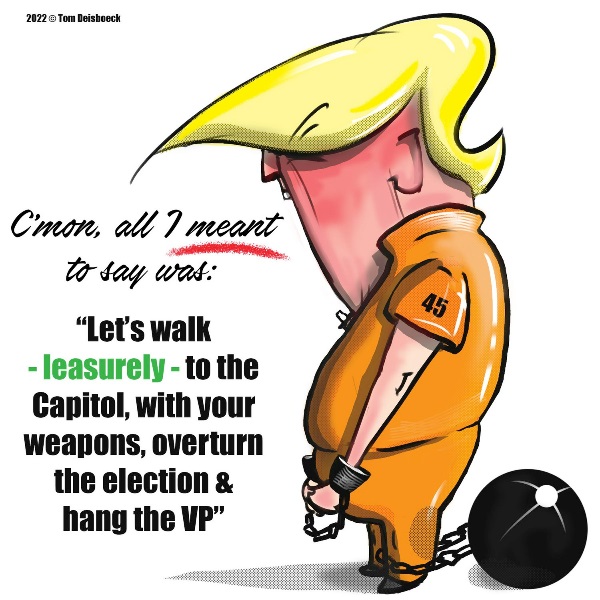
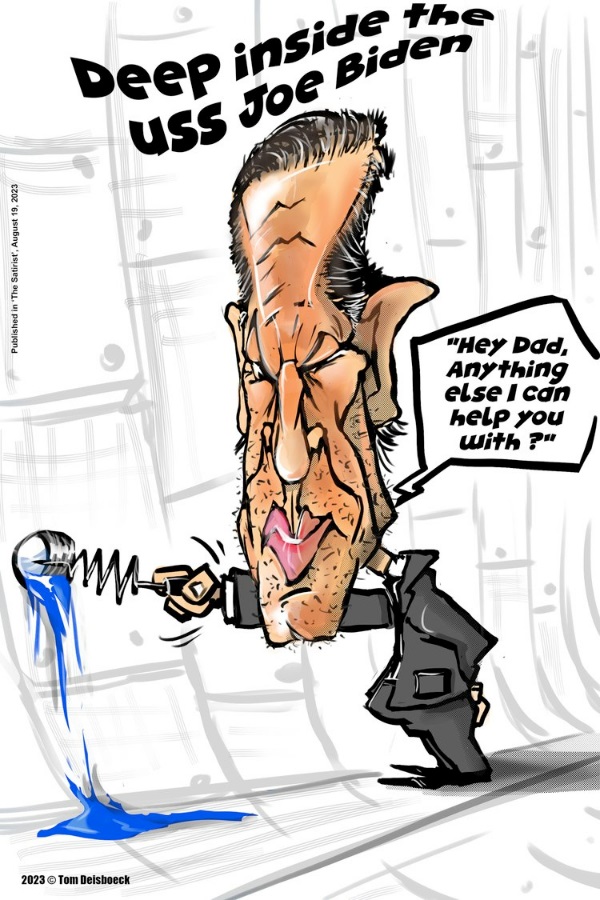
JK: What can an illustration do that a regular photograph or video or maybe even animation can’t? What makes it so special?
TD: Ideally, you have a combination of a snapshot and a caption that’s not restating the snapshot. If you need to have a caption or a tagline to explain the art, it’s very likely that the drawing as a standalone isn’t good enough. It’s a combination of the two that makes it humorous, at least that’s what I try to do with potentially serious topics. It makes it more approachable and more digestible without losing depth. In the classic cartoon, it’s a two-dimensional snapshot out of a sequence of things that could have happened before or could have happened after. It’s one snapshot in a sequence of animation. The best cartoons can engage and make people think about it without turning them off. But it’s a combination of entertainment and conveying a sometimes difficult or critical viewpoint of a topic that makes cartooning interesting, more so than a photo, I’d say. Honestly, it's less work than an animation gif or video.
JK: In this more politicized culture, I wonder if it’s more difficult to do that without getting in trouble or turning a bunch of people off.
TD: As we saw in the last election, in this country, you’ll have 75 million people against you either way. The only way to deal with this is to try to be an equal opportunist critic. That is, make fun of both sides. It’s a safe mathematical statement that there are more progressive, slightly more liberal cartoonists than conversation ones. I grew up in Munich, Germany, and I came to Boston in 1997. In the ‘80s, it was the heyday of editorial cartoonists dealing with Ronald Reagan. Reagan, much like Trump, had a very distinct look to him. Cartoonists had a field day with him too.
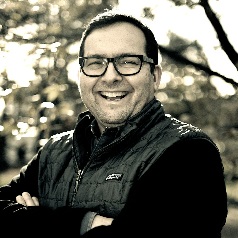
Thomas Deisboeck
JK: Let’s talk about your path. I know you got your MD from the Technical University of Munich and then an MBA from MIT. Now, you’re an associate professor for radiology at Mass Gen and Harvard. You’ve done, and I’m reading directly from your bio here, “pioneering research in the field of computational cancer systems biology.” I know you’ve talked about innovating in health communications. Why did you end up taking that route? How’d you end up here?
TD: I tried to combine the more analytical and the entertainment sides of my brain. Either that or I was just phenomenally unfocused. To my credit, I did draw in high school. I completely let it go when I went to medical school and the beginning of whatever scientific career I had. Then, I picked it up again years ago. I like the artistic side. I’m perennially on the lookout for projects that combine innovations in healthcare and tech with the arts. One specific interest is using healthcare communication in a way that’s more inclusive and engaging and cuts through the noise. We saw with the COVID situation that it’s super important. I’ve also done children’s book illustrations, NFT illustrations. There aren’t probably that many cartoonists who are also medical scientists, even though there are a ton of medical people who have considerable artistic talents.
JK: Did you ever have thoughts about doing clinical work?
TD: I did do clinical work in Germany. I did my last year in medical school in the States. I toured through Pittsburgh, New York, and Phoenix, and I went back [to Germany] and started work in neurotrauma and neurosurgery. I transferred from there to a post-doc job offer at MGH (Massachusetts General Hospital), worked on anything from neuroscience and gene therapy to oncology research and computational biology—first in neurosurgery; now in radiology. The rest is history, as they say. I got my MBA back in 2011, and in the program out of 100-plus people, there were only two MDs. It’s difficult to learn again after 10 years of being out of school. But I felt I needed to have more rigorous training to move into innovation strategy consulting and all the venture-related things I do now. It is like any other business program. It’s about the networking, about the perspective, about setting time aside to think differently and to pursue new paths. It’s being creative with your career. There also is a business side to the arts, such as on NFTs or getting paid for published cartoons.
JK: You started drawing in high school and then stopped when you went to medical school. Did you miss it? Why did you pick it back up again?
TD: I don’t think at the time that I consciously missed it. It’s a completely different muscle. A lot of medical school is learning things by heart, or at least was back then. Now, a lot of that knowledge is a WiFi connection away. It’s more emphasis on the application of knowledge and the transmission of knowledge and how you apply it instead of being a walking dictionary. When I grew up, that was it. That’s fundamentally different from a creative process.
As far as I see it, a well-trained physician doesn’t really skip steps. They just tend to go through the process intuitively faster, led by the guiding principle: ‘The common things are common, and the rare things are rare.’ In creativity and disruptive innovation, you actually do skip steps. You don’t follow the pre-formed paths and reinforce them, and you don't move things incrementally. Rather, you follow inspiration and creative freedom wherever they lead. If there was anything that pointed to a more creative side, I tried to push my academic focus to the intersection of disciplines. It’s a lot of unexpected things that happen at the intersection. We started early on to work with computer modeling and with applied physics and math biology. We took ideas from one field and applied them to another. That was, still is, interesting, and that was creative. It was abstracting those concepts and giving them new life and new meanings and the challenges of translating all that and being mindful of limitations but also of the enormous potential to chart new paths. That was an early indication that just pursuing the same paths wasn’t that exciting to me.
Once I accomplished a lot of the scientific things I had set out to do, I got interested in drawing again. I went to Los Angeles and met with a cartooning animation teacher and started from there doing remote classes. That was about nine or 10 years ago. Before that, I stayed connected to the field by collecting classic Disney animation drawings. I appreciated the art form and wanted to get involved myself. Much like in other things, I needed to get some training done.
JK: What’s your favorite Disney piece?
TD: I have things from Pinocchio and Fantasia and so forth. These are the original drawings from the golden age of animation..
JK: Wow, original pieces. So cool.
What about finances? Did that ever play a role in what you wanted to do? If you had gone into neurosurgery or oncology, you’d know what kind of income you could expect.
TD: I did what I set out and wanted to do. That was more important than financial rewards. But I also grew up in a governmentally run university system in Germany that didn’t set me up with the student loan debt structure that besets a lot of people here. That didn’t have to be a concern because of the system, as opposed to here where med school graduates favor particular subspecialties primarily because of remuneration. My MIT (masters) program certainly wasn’t free, and I’ve worked part-time in consulting and commercial products since, so I do understand the value of financial rewards. They just aren’t the exclusive driver to pick projects. I get easily bored when things turn to one direction, even if it’s smooth. It’s much more interesting when there are new ideas and new disruptive technology that needs to be thought about and strategized about instead of doing the same thing over and over for 25 years.
JK: I don’t know what your style of drawing is called or if you even have a quote-unquote style.
TD: That makes two of us.
JK: But one thing I did notice was that you don’t draw faces on the people who are in your art unless you’re drawing somebody famous. What’s the rationale behind that?
TD: With some of the editorial work, I do the faces but I abstract them, pretty much what we probably all do subconsciously when we look at photos. It’s Trump’s hair or Biden’s glasses or Obama’s ears, often grotesquely emphasized. On the humor side, particularly if I want to get an illustration for the caption, it doesn’t really matter to see the face of, say, a physician. It’s enough if you do the coat and the glasses to convey it’s a doc. A detailed face doesn’t add to it.
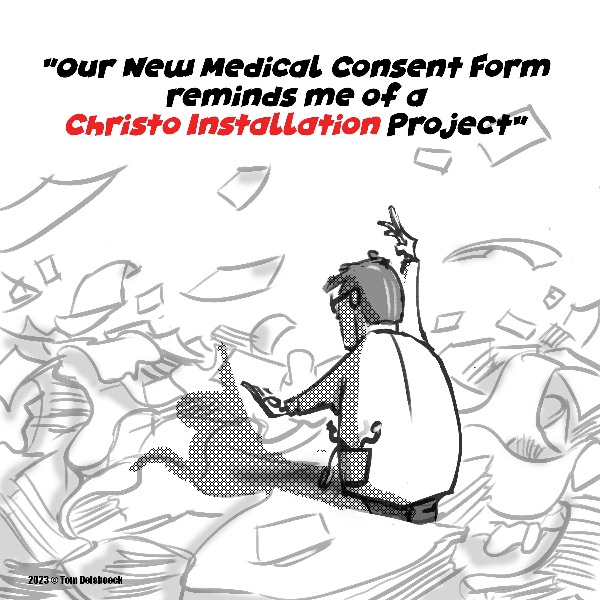
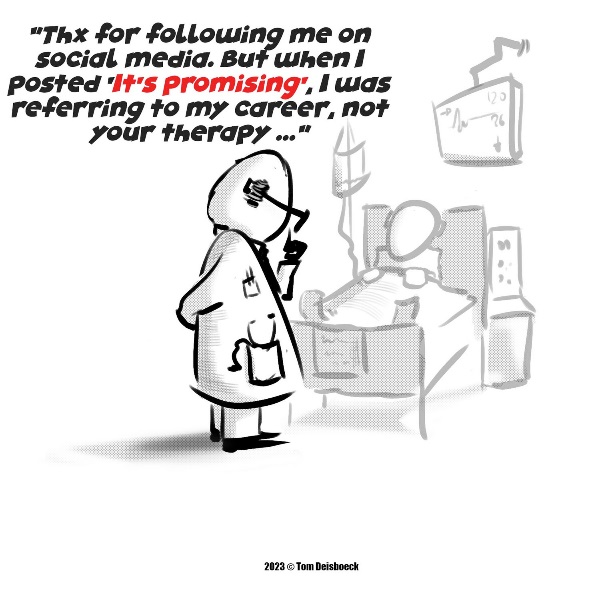
JK: My dad was a longtime industrial designer and toward the end of his career, he lamented the fact that so much of his job was illustrating on a computer rather than him drawing by free hand. Do you feel that way at all?
TD: When I was in high school, this was about the same time computers began really coming up. There was no way of drawing on the computer, no Photoshop. There was microfiche to store and view data, which really dates me. I started out on paper and blue pencil. But if you get to an acceptable level with direct-to-digital, you can do things much faster. I will agree with your dad about the interaction of holding the paper and raising the pencil and going back and forth and the various shading that you can accomplish just by a change of the pressure. It’s completely different. No matter how sophisticated the computer programs have gotten—and they are very good—it’s a very different quality and feeling.
JK: I guess the big question: Aside from everything else you’re doing in your career with the research and the innovation, can your cartoons make the difference you want to see?
TD: Let me start with healthcare communication, which still can be explored with more depth. I do feel that with the accessibility of knowledge, which we now have 24/7 with numerous platforms (with the caveat that we must maintain quality standards) and working on the visualization side with how we distribute and communicate difficult topics, cartooning/animation/illustration definitely has a role. There is the possibility of accentuating messages with humor—not ridiculing the situation but making the serious or educational element more digestible. Walking that line is not an easy one, but it’s worth exploring. We really need to improve the way we talk with patients in healthcare. As to my editorial cartoons: there is no question that the role of the medieval court jester, the precursor of the editorial cartoonist if you will, has never been more important than today when more autocratic regimes around the globe aim at muting critical voices and diverse opinions. So, yes, every effort on pushing back counts, including mine.
More information here:
A Winning Hand: Meet the Lawyer Who’s Making Huge Money at the Poker Table
Pickleball’s Newest Sensation Is a First-Year Medical Student Who Just Came Out of Nowhere
Money Song of the Week
For the first time in 17 years, I saw Pearl Jam in concert this week, and though I don’t listen to much of the discography after the first three albums, the band is still one of my grunge favorites. Well, Pearl Jam used to be grunge, but now it's just a bunch of nearly 60-year-old dudes who put on a phenomenal rock show. And while Pearl Jam ultimately lost the battle against Ticketmaster and its greedy monopolistic ways in the 1990s, the band hasn’t stopped trying to make a statement with its music.
Take, for instance, 2002’s “Green Disease” where singer Eddie Vedder laments corporate greed.
As he sings,
“There’s a disease, and they're all green/It emanates from their being/A satiation with occupation/And like weeds, with big leaves/Stealing light from what's beneath/Where they have more, still they take more . . .
“Well I guess there's nothing wrong with what you say/But don't sell me there can't be better ways/Tell the captain, ‘The boat's not safe and we're drowning’/Turns out he's the one making waves, waves, waves.”
As Vedder said in the Pearl Jam Twenty book, “I'm not saying capitalism is what's wrong about this; it's more like corporate responsibility. You can't tell me there's not other ways of making it good for everybody.”
Tweet of the Week
When you think about it, this is actually the opposite of the Green Disease.
[Editor's Note: For comments, complaints, suggestions, or plaudits, email Josh Katzowitz at [email protected].]
The post Meet the Doctor Who’s Using His Art for Disruption and Innovation appeared first on The White Coat Investor - Investing & Personal Finance for Doctors.
||
----------------------------
By: Josh Katzowitz
Title: Meet the Doctor Who’s Using His Art for Disruption and Innovation
Sourced From: www.whitecoatinvestor.com/thomas-deisboeck-editorial-cartoonist-doctor/
Published Date: Sun, 24 Sep 2023 06:30:35 +0000
Read More
Did you miss our previous article...
https://peaceofmindinvesting.com/investing/private-charitable-foundation-vs-donor-advised-fund
.png) InvestingStocksToolsClubsVideosPrivacy PolicyTerms And Conditions
InvestingStocksToolsClubsVideosPrivacy PolicyTerms And Conditions
